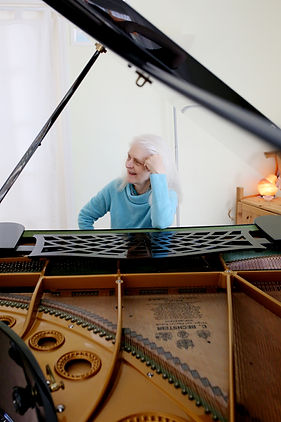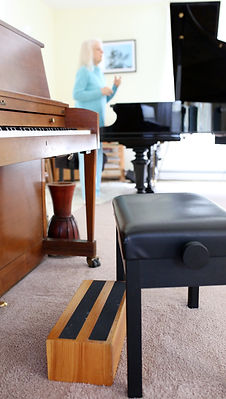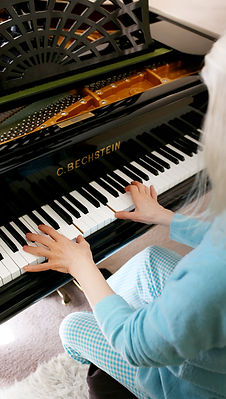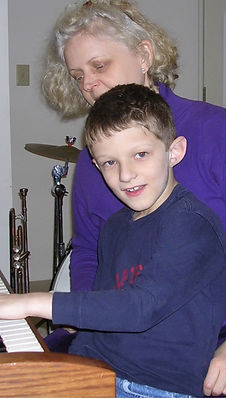
Teaching Music
Nurturing Growth
My Teaching Philosophy
I see all my music teaching as an opportunity to help everyone I work with grow and develop, regardless of the specific goals they may have to begin with. Embedded in my approach is activating my students' singing, developing their ear, and training them to feel the difference in their music making when they think of giving it out to help others. Whenever possible, I take them to sing with the seniors at local retirement communities (see Music Outreach below).
My approach to music teaching is designed to be fun as well as rewarding, nurturing the student’s natural love of music throughout the process. The focus is less on music as a skill and more as a means to expand their capacity to live their lives to the fullest.

What Happens in a Lesson

There are two pianos so we can make music together.
I individualize my approach to the different needs, tastes, and abilities of each student. I typically start with a new student by asking them about the types of music they enjoy and who their favorite singers are. If I am not familiar with the material, I will go and listen to it.
I also strive to broaden my students’ musical repertoire and will often suggest that they listen to songs from different genres, and recommend that they listen to several different performances, even see a video clip, as it is highly educational. We then discuss what they like/dislike, and over time, a natural collaborative relationship develops. It also encourages students to bring in music that they want to learn/sing.
I will often get my younger students to move around the room and/or make up dance moves to different types of music that I play and sing on the piano. This is a great assessment tool, as I can see their physical creativity, coordination, and how the movements match the type of song that I am playing for them.
For my very young students and children with disabilities, I will also get them to hop, skip, gallop, as well as rolling on the floor, and it shows me what they can do and where they need help. These are all well-known developmental milestones and help to develop many other skills important to navigating their world.
Another technique is to get my students to play the rhythm of the song’s words on a drum or a body part. This is a great foundation to develop their listening and coordination. I always start with simple chants and nursery rhymes, moving to more complex material as we go along. Over time, they will learn how to convert the songs they hear in their minds into the finger movements relevant to their instrument of choice. They also naturally come up with new words to songs they are already familiar with.
Many of my students are reluctant to sing, so we work through this together. Singing accelerates our ability to learn to make music by helping us integrate it into our system more effortlessly.
We begin with songs that are easy and fun to learn and sing, i.e., folk songs like Home on the Range and parlor songs like Let Me Call You Sweetheart, Daisy Bell, or When Irish Eyes are Smiling. These songs were created for communities and families to sing together in informal settings. They’re quick to learn and they’re fun.
For more complex material, I turn to what is known as the Golden Age of American Popular Song. Many of the names of its creators are familiar and include George Gershwin, Jerome Kern, and Irving Berlin. But there are also many forgotten composers of many unforgettable songs.
These songs have not only great quality (which explains their continued popularity) but also span a remarkably wide emotional range. They cover everything from fun songs, like Five Foot Two, Eyes of Blue, to torch songs which plumb the depths of feeling, like Carmichael’s The Nearness of You.
The goal is to become comfortable making meaningful music. Where we go from there is up to you
Teaching Materials

Music Outreach

We all have a natural, inborn ability to make music. It is the unhesitating impulse of a mother to sing to her child to soothe it, to make it feel better, not to call attention to herself or her own vocal performance. She is making a gift of her lullaby to her child. Doing this, she does not need to wonder if she is singing in tune or whether she is ready for Carnegie Hall.
We activate this generous impulse to give of ourselves every time we go and sing with, not to, seniors at retirement communities. The purpose is to help these older people feel better, not to get a top score in a competition.
Outreach programs take place in senior and assisted living facilities, where your music will awaken a profound joy, a sense of well-being for you and for others, that will have you wanting to come back week after week. And like magic, week after week, your music – and your well-being – will increase.
This was illustrated for me by one of my music students, only five years old. During our last music session, she was singing one of her favorite songs and playing the drums, while I was playing the piano. Then she spontaneously made up a song to all her grandmothers (they are all in heaven), and another song for all her grandfathers, who are also in heaven. In the process of offering them her songs, she was connecting directly with them – despite the great distance between earth and heaven – she now sings and plays to the baby chickens that she has at her house.